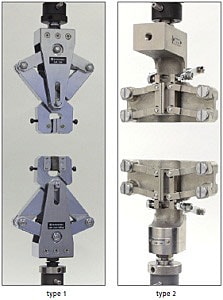Type 1 and Type 2 Pantograph Grips

Features:
- Ideal for testing rubber, textiles, and soft plastics
- Type 1 and type 2 models with maximum capacity of 1 kN (220 lbf) and 5 kN (1,100 lbf)
- Quick clamping mechanism with a self-tightening action
- Fitted with parallel-grooved grip faces for securing soft specimens
Relevant Materials:
Rubber, Soft Plastics, Textiles
Relevant Specimens:
Plates
Pantograph grips use a simple spring design to hold and apply pressure to specimens during tensile testing. These grips are mainly used for tensile testing plate specimens of rubber, textiles, or soft plastics.
There are two types of pantograph grips: type 1 and type 2. Type 1 pantograph grips suit wider, thinner samples, whereas type 2 pantograph grips are better for narrower and thicker samples. Both grip types are fitted with parallel-grooved grip faces to enhance soft specimen clamping.
News / Events
-
AUTOGRAGH AGS-X2 Series has been released
The Shimadzu AUTOGRAPH AGS-X2 series provides superior performance and practical testing solutions for a wide array of applications. Offering high-level control and intuitive operation, the AGS-X2 series sets a new standard for strength evaluations while providing the utmost in safety considerations in a modern, stylish design.
-
AUTOGRAGH AGS-V Series has been released
Shimadzu Corporation released the Autograph AGS-V Series precision universal testing machine. In this series, the range over which the force measurement accuracy is guaranteed has been increased by a factor of two compared with existing machines. As a result of this new function, the work required to change force measurement sensors and accessories required for measurement can be reduced.
-
High-Speed Video Camera HyperVision HPV-X3 has been released
Recording speed of 20 million frames/second, the highest in its class provides larger, clearer, high-sensitivity recording. HPV-X3 is equipped with a synchronized recording function and high-level analytical capabilities that accommodate a variety of software programs.
-
New Video: AUTOGRAPH AGX-V2 Voice Operation Device XV-Talk
We will introduce how XV-Talk, the world's first voice control device installed in Shimadzu's latest tensile tester AGX-V2, can be used in various scenarios.
-
New Video: AUTOGRAPH AGX-V2 Operation Control Panel Stand-alone test feature
We will introduce a new feature of Shimadzu's latest tensile tester, AGX-V2, a stand-alone testing function using a large color LCD touch panel.
-
New Autograph AGX-V2 Series Precision Universal Testing Machines
The World’s First Testing Machines Equipped with a Voice Operation Device


